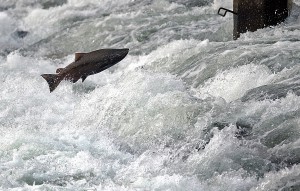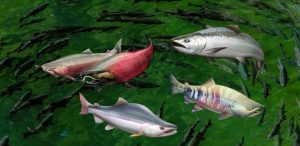The California Department of Fish and Wildlife (CDFW) has released an important progress report on the California Salmon Strategy for a Hotter, Drier Future, outlining the state’s ongoing efforts to restore and protect salmon populations across California’s waterways.
A Critical Time for Salmon
Salmon populations are facing immense challenges due to climate change, drought, habitat loss, and human-made disruptions. Healthy salmon runs are vital not only for California’s ecosystems but also for the fishing industry, recreational economies, and the cultural traditions of Native American tribes. The 2024 Salmon Strategy laid out a bold plan to restore and rebuild salmon populations, and this latest progress report highlights the measurable steps being taken to achieve these goals.
Progress at a Glance
The report provides an update on 71 action items designed to improve salmon migration, enhance spawning and hatchery operations, expand habitat restoration, and secure reliable water flows. Encouragingly:
- 67% of projects are actively in development
- 26% of action items have already been completed
- Only 7% remain in early planning stages
This demonstrates a strong commitment by state agencies, tribal partners, and environmental groups to ensuring salmon populations remain resilient for generations to come.
Key Accomplishments in Salmon Conservation
Several major milestones have been reached over the past year, making significant strides in salmon recovery:
- Removing Outdated Dams – The removal of the Klamath River dams has restored natural river flow and allowed fall-run Chinook salmon to return to long-lost spawning grounds.
- Improving Salmon Migration – The Big Notch Project in Yolo County, spearheaded by the Department of Water Resources (DWR), is helping salmon navigate key migratory routes, improving their access to critical habitat.
- Building Healthy Habitats – The Salmon Habitat Restoration Prioritization Initiative (SHaRP) has received over $30 million in funding for habitat restoration projects, including floodplain improvements, riparian restoration, and spawning habitat enhancements. Projects like Lookout Slough Tidal Habitat Restoration are already adding thousands of acres of beneficial salmon habitat.
- Ensuring Healthy Water Flows – Scientists are developing new models to establish minimum flow requirements for the Scott and Shasta Rivers, setting a precedent for similar protections across the state.
- Innovative Salmon Tracking – The implementation of Parental-Based Tagging uses DNA technology to more accurately track and monitor salmon populations, ensuring better management and conservation strategies.
The Road Ahead
“California salmon are vital to our environment, economy, and heritage,” said California Natural Resources Agency Secretary Wade Crowfoot. “While we’ve made significant progress, there is still much work ahead to secure thriving salmon populations.”
The commitment to restoring salmon runs remains stronger than ever. With continued collaboration, investment, and scientific innovation, California is proving that a hotter, drier future does not have to mean a future without salmon.
Get Involved!
Protecting salmon requires community action and advocacy. Whether it’s supporting local restoration projects, engaging in conservation efforts, or staying informed, every effort helps ensure that salmon populations continue to recover and thrive.
Together, we can ensure a future where salmon remain a vital part of California’s waterways.
Download Report >>


